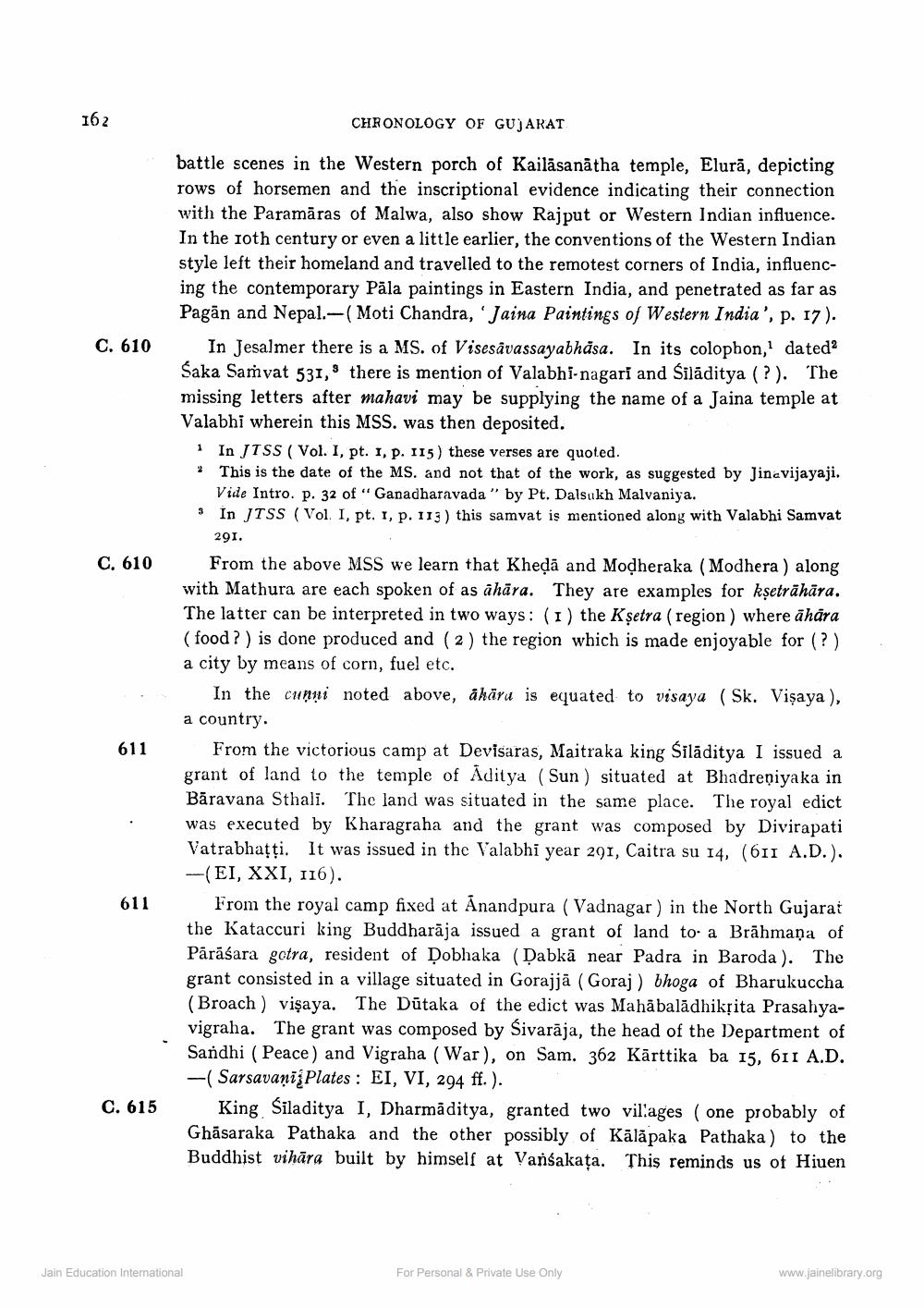________________
162
C. 610
C. 610
611
611
C. 615
CHRONOLOGY OF GUJARAT
battle scenes in the Western porch of Kailasanatha temple, Elură, depicting rows of horsemen and the inscriptional evidence indicating their connection with the Paramāras of Malwa, also show Rajput or Western Indian influence. In the 10th century or even a little earlier, the conventions of the Western Indian style left their homeland and travelled to the remotest corners of India, influencing the contemporary Pala paintings in Eastern India, and penetrated as far as Pagan and Nepal.-( Moti Chandra, 'Jaina Paintings of Western India', p. 17).
In Jesalmer there is a MS. of Visesävassayabhāsa. In its colophon, dated Saka Samvat 531, there is mention of Valabhl-nagart and Śladitya (?). The missing letters after mahavi may be supplying the name of a Jaina temple at Valabhi wherein this MSS. was then deposited.
1 In JTSS (Vol. I, pt. 1, p. 115) these verses are quoted.
2 This is the date of the MS. and not that of the work, as suggested by Jinavijayaji. Vide Intro. p. 32 of "Ganadharavada" by Pt. Dalsukh Malvaniya.
3 In JTSS (Vol. I, pt. 1, p. 113) this samvat is mentioned along with Valabhi Samvat 291.
From the above MSS we learn that Kheda and Modheraka (Modhera) along with Mathura are each spoken of as ahara. They are examples for kşeträhära The latter can be interpreted in two ways: (1) the Kṣetra (region) where dhara (food?) is done produced and (2) the region which is made enjoyable for (?) a city by means of corn, fuel etc.
In the cunni noted above, ahara is equated to visaya (Sk. Visaya),
a country.
From the victorious camp at Devisaras, Maitraka king Siläditya I issued a grant of land to the temple of Aditya (Sun) situated at Bhadreņiyaka in Baravana Sthali. The land was situated in the same place. The royal edict was executed by Kharagraha and the grant was composed by Divirapati Vatrabhatti. It was issued in the Valabhi year 291, Caitra su 14. (611 A.D.). -(EI, XXI, 116).
Jain Education International
From the royal camp fixed at Anandpura (Vadnagar) in the North Gujarat the Kataccuri king Buddharaja issued a grant of land to a Brahmana of Pārāśara gotra, resident of Dobhaka (Dabká near Padra in Baroda). The grant consisted in a village situated in Gorajjā (Goraj) bhoga of Bharukuccha (Broach) visaya. The Dütaka of the edict was Mahabaladhikrita Prasahyavigraha. The grant was composed by Sivaraja, the head of the Department of Sandhi (Peace) and Vigraha (War), on Sam. 362 Kärttika ba 15, 611 A.D. -(Sarsavani Plates: EI, VI, 294 ff.).
King Siladitya I, Dharmaditya, granted two villages (one probably of Ghasaraka Pathaka and the other possibly of Kalapaka Pathaka) to the Buddhist vihara built by himself at Vanśakata. This reminds us of Hiuen
For Personal & Private Use Only
www.jainelibrary.org




